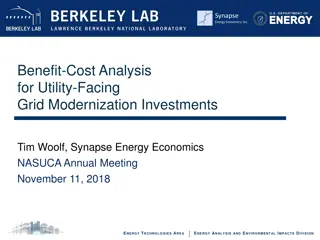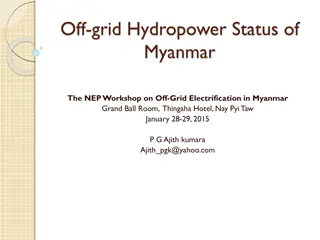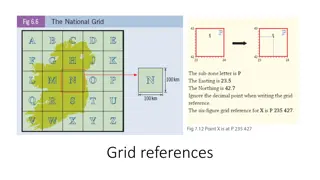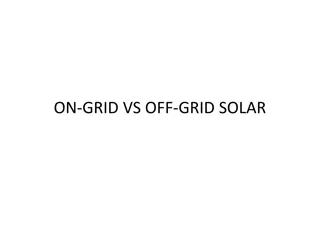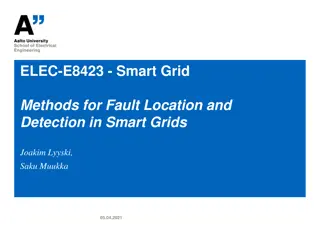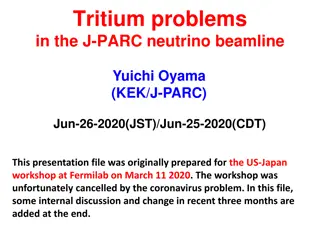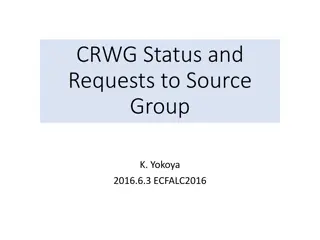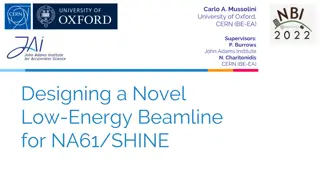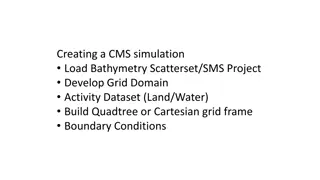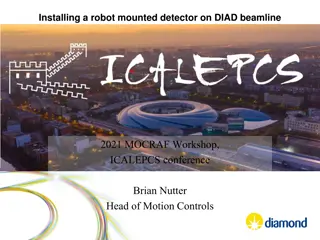APTM and GRID Beamline Elements
Presentation of beamline instrumentation concepts, project planning, and objectives for measuring beam properties at the European Spallation Source. Details include systems overview, beam monitoring instruments, tuning processes, and key parameters such as power, current, and pulse duration.
- Beamline Elements
- European Spallation Source
- Instrumentation Concepts
- Beam Properties
- Project Planning
Download Presentation

Please find below an Image/Link to download the presentation.
The content on the website is provided AS IS for your information and personal use only. It may not be sold, licensed, or shared on other websites without obtaining consent from the author. Download presentation by click this link. If you encounter any issues during the download, it is possible that the publisher has removed the file from their server.
E N D
Presentation Transcript
APTM and GRID Beamline Elements Dr. Cyrille Thomas Beam Instrumentation European Spallation Source ERIC Date
Outline Introduction: Presentation of the systems concept and overview Concepts for the APTM and for the GRID BLE and Electronics Projects Project planning Concluding remarks 2
Concept and Overview Suite of instruments to measure beam properties on target: Size, position (IMG) Current density distribution (IMG, GRID) Beam outside defined aperture (APTM) oScale time: Intra-pulse, pulse, cumulative pulses Objectives: Support beam on target tuning: establish nominal operation protection Support beam on target operation (production): monitor protection 3
Beam on Dump BPM: phase, position, trajectory Blind to long bunch BCM: peak current along pulse APTM: charge loss into the defined aperture Measure all charges from s to minutes Can be biased by secondary electrons IMG: beam transverse 2D profile, peak current density distribution Detects small beam size Limitation in dynamic range: too large beam size may not be seen 4
Beam on Dump Tuning for every pulse: Verify beam size predicted by the model MPS on: check beam size larger than s sth(mode dependant) Check beam current on aperture (protection) Check trajectory and divergence (protection) APTM Current / sectors (MS /s) Temperature / Thermocouples IMG 314k 1 A X1, Y1, sx1, sy1 X2, Y2, sx2, sy2 4 A 3 A Screen 2 DX, DY, Dsx, Dsy Screen 4 360k 350k 0.8 A 310k Image 1 Screen 1 Dump Image 2 APTM 5
Beam on Target NSW Accelerator region Target region TW Heine Thomsen (ISA, Aarhus University) A2T and Raster Magnets CO PBW PBIP BEW BPM BCM NPM APTM: beam aperture (protection) GRID APTM IMG (x2): current density APTM BPM: phase, position BCM: peak current NPM: beam profile, size, positon WS: (low power) beam profile, size
Beam parameters: Power: 2MW Peak Current: 62.5mA Avg Current: 2.6mA Pulse: 2.86 ms Beam on Target APTM 314k 314k 1 A 1 A FFT peaks V: 29kHz H: 39kHz H. GRID 4 A 3 A 4 A 2 A 360k 360k 350k 350k 0.8 A 310k 0.9 A 310k PBIP PBW IMG Max peak density: 50% Max peak density: 30% V. GRID PBW BEW 7
Concepts for the APTM APTM in the Target Monolith: Beam centering in the target monolith. Determination of the total beam current outside of the desired footprint. The system must function with full production beam. Provided measurements at reduced beam power. Baseline: two locations in the monolith The opportunity for maintenance and/or replacement occurs every 6 months at the time the major shutdowns. Interlock with FBIS APTM in the Tuning Dump: Limit the power deposition near vacuum seals Avoid thermal stress in the beam pipe itself. One location is foreseen just upstream of the dump. Interlock with FBIS APTM in the NSW: Observe the beam halo, protect the shield wall components such as the pipe itself and the BPM located in the centre of the wall. Permit tuning and to accommodate risk of damage from the beam Required location for the NSW APTM is just upstream of the NSW centre, but still within the NSW itself. Interlock with FBIS 8
Concepts for the APTM Thermocouples (type K) J-PARC APTM Prototype (ESS / IMP) Metallic Blades (Ni) Thermocouples: charge induced temperature: 2x per position: gives temperature gradient Slow (many pulses) but highly sensitive Metallic Blades: charge induced current Several blades per side: finer halo mapping Fast detection, s scale, but less sensitive J-PARC APTM (courtesy S. Meigo) 9
Concepts for the APTM Beam: 400 MeV, 50mA, 50 s, 0.4Hz Beam: 2 GeV, 50mA, 400ns, single shot 600 Blade 1: 2GeV, 50mA, 600ns 500 Scan APTM 400 intensity ( A) 300 200 100 0 -100 0 50 100 150 200 250 300 350 400 450 500 time ( s) Temperature rise and decay as expected Intense signal: Full beam intercepting theo. peak current: IB= 2mA Strong 26kHz coupling: can detect rastering 10
Concepts for the GRID Measure beam current density 1D profile in both axis Measure Horizontal and Vertical position of the beam Detect 1D current density out of nominal condition Detect position of the edges of the beam out of nominal values Detect the beam to be rastered Interlock with the FBIS Operating range over peak current range condition (6mA to 62.5mA): permit fast tuning Permit production and monitor beam during production 11
Concepts for the GRID Three layers of wires: Hor. Vert. and Diag. Diag. wires for bias Fast detection, s scale, A sensitivity Detection of current in each wire Detection of raster J-PARC APTM (courtesy S. Meigo) J-PARC GRID Prototype (ESS / IMP) 12
Concepts for the GRID Grid on APTM 24mm out Fast sampling: can detect raster Bias on APTM: -30V Retrieval of profile Beam: 50mA, 500 s, width = ~2mm 800 200 Grid Position =554 mm APTM Position =530 mm shot #: 240 V Grid Wire Intensity ( A) 600 150 Intensity (mC) 400 Position =-2.79 mm =1.91 mm shot #: 240 100 200 50 0 0 -200 0 200 400 600 800 1000 -8 -6 -4 -2 0 2 4 6 8 time ( s) Position (mm) 13
BLE and Electronics Projects Two instruments types with many similarities: Current reading range Radiation hard environment Interlock to FBIS (intra-pulse) and to BIS (pulse period or longer) Same Electronics will be used: one Electronics development serving both instruments types Same MC simulations to support BLE design Same time scale, both to be delivered at various times for integration and to be ready for beam on Dump and on Target BLE project run in-house Electronics design by LTH collaborators (Anders J Johansson) 14
Operation and Maintenance Supporting Beam Tuning and Operation: Assure signal quality at all time: high signal to noise ratio in current range 6-70mA Assure reliable detection of errant beam condition: fast signal processing ( s range) to permit FBIS trigger Permit Fast beam tuning: deliver single shot beam and halo properties Radiation damage and errant beam condition damage: prepare maintenance plan NSW and TD: risk of damage from high power small beam, possible activation of the APTM PBIP and PBW: regular change of the plugs, due to radiation damage 16
Project planning Delivery of PBW Delivery of PBIP 2020 2021 2019 CDR PDR Proposal for next test series at J-PARC Production prototype head #2 Prototype tests at J-PARC Electronic on MEBT Scrappers Demonstration Electronic platform with ICS supported FMC Final Electronic Design Electronics for NSW, TD, PBIP First Complete Design 4 APTM and the GRID MC simulation and Thermo- mechanical model BLE APTM PBW BLE for NSW, TD, PBIP Final Mechanical Design APTM Beam on Dump Beam on Target 17
Concluding remarks Conceptual design advanced in many aspect: o Functionalities defined o Interfaces identified and in place o Performance derived from interfaces and functionalities o Prototypes designed and tested in real and similar condition Projects Time Schedule and milestones defined and aligned with other dependant projects Support from collaborations J-PARC and SNS Note: Constraints of physical integration in Target Monolith (not mentioned): risk (accepted) of performance reduction 18
Review Outline Electronics for the APTM and GRID Anders J Johansson Target Plugs for the Beam on Target instrumentation: PBIP and PBW Mattias Wilborgsson Control Systems for the APTM and GRID Joao Paulo Martins MC calculation for the APTM and GRID Dr. Elena Donegani 19




